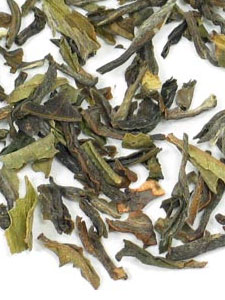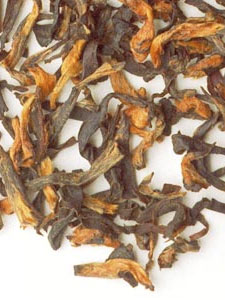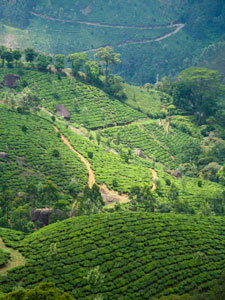Indian Tea




Originally cultivated by the British in the early 1800's to meet high international demand and exceptional standards, tea is commercially grown in three primary areas of India: Darjeeling in the north, Assam in the northeast, and Nilgiri in the south.
Darjeeling
Darjeeling is one of the world's most revered tea growing regions. This relatively small area lies high in the foothills of the Himalayas at elevations of 3,000 to 6,500 feet. Today there are more than 80 Darjeeling tea gardens in an area of less than 70 square miles. Here, the "Champagne of teas" is grown. To give you a sense for the value of this origin, it is widely estimated that 70% of the tea sold around the world as "Darjeeling Tea" was not actually grown in Darjeeling. Some governing bodies, such as the European Union, have given legal protection to the name "Darjeeling". Only teas produced in the region, produced to its standards can legally be labelled "Darjeeling." Among black tea drinkers, Darjeelings are prized for their unique characteristics and exceptional quality.
The notable difference between Darjeeling teas and almost any other is the characteristic "Muscatel" flavor. The muscat grape is prized for its sweet, floral notes and is used to make dessert and sparkling wines. Teas from Darjeeling often exhibit this bright, sometimes sharp characteristic. The extreme altitude plays a significant role in flavor development. Darjeeling black teas are often very colorful, with shades of gold, brown, green and white in the dry leaf. They have a lighter, golden liquor, with a floral, "greener" flavor than most black teas. Leaves growing at this altitude are more tender and fragile, and often dry up entirely during the tea making process (rolling, oxidizing, etc). So, you're experiencing a very different spectrum of flavor in a cup of Darjeeling tea.
The growing season in Darjeeling is divided into four periods:
First Flush lasts from March through April and produces the first, tender shoots of the season. Because the plants have been storing nutrients all winter and the cool weather prevents rapid growth, they offer a very high concentration of the polyphenols that give tea its characteristic astringency. First Flush Darjeelings are generally less oxidized during processing and appear much greener than most Black teas. Example: Spring Darjeeling.
Second Flush runs from May through June and the increased warmth and sunshine result in more rapid growth. During the second flush the bold muscatel flavors come to the forefront and the finished teas take on a stronger, smoother character. Most Darjeeling tea on the market is from the second flush, and is often not labeled as such, simply because selections from the other seasons are far less common to see for sale. Example: Darjeeling Puttabong.
Monsoon season lasts from July to early October. The heavy rains and heat drive rapid leaf growth, but this same speed and "easy growing conditions" result in much more muted flavors. "Monsoon Darjeelings" are usually used for iced or bagged teas.
Autumnal Flush lasts from early October to mid-November. As the temperatures cool and the soil dries out, the plants are again stressed and forced to put all of their efforts into the final few leaves before their winter hibernation. Autumnal teas are often rich and smooth with a nutty, sometimes woody characteristic that is remarkably different from the briskness of the First Flush.
Assam
The Indian state of Assam lies in the northeast corner of the country. Annexed by the British in 1838, the climate and culture of this region shares more in common with South East Asia than with India. Assam's warm climate, intense rainfall and loamy soil combine to make this area the world's most prolific tea producer. There are currently around 800 tea estates in Assam.
Whereas the Darjeeling gardens grow mainly the smaller leafed Camellia sinensis sinensis variety from China, Assam is home to the appropriately named the Assamica variety. The discovery of wild Assamica trees growing in the jungles of the region leads some botanists to believe that India is one of the birthplaces of tea. Nearly all of the tea in Assam is grown at or near sea level and the Assamica plants thrive in the warm, sunny conditions. The highest quality leaves are grown in the spring, but Assam produces tea all but a few months of the year.
Assam teas are very bold, rich and astringent. Depending on the tea, you can expect notes ranging from malt and caramel to honey and butternut squash. Most Assam teas show a slight nuttiness and earthiness. These powerful teas are perfect partners for cream and sugar. Example: Example: Assam Harmony
Nilgiri
The Nilgiris, or Blue Mountains, lie at the southwestern tip of India. This is an area of sweeping grasslands, dense jungles, home to herds of elephants. It's also one of the few remaining natural habitats for Bengal tigers. The Nilgiri mountains rise to a height of 6,500 feet and receive an incredible 80 inches of rain each year.
Tea production began in Nilgiri in 1840 and today there are more than 60,000 acres under cultivation. As a result of the low latitude and warm, moist conditions, the tea plants bud year round. In fact, this is one of the few regions that receives two monsoons each year. Nilgiri teas are strong and well-balanced, with a smooth, rounded flavor. They are often used as the base for tea blends. Nilgiri also produces a rare type of tea, known as a "frost tea", where the leaves are harvested in the winter. The quick chill creates a concentrated sweet and rosy flavor in the leaves, very similar to what you would find in an "ice wine."
 teaclass
teaclass
